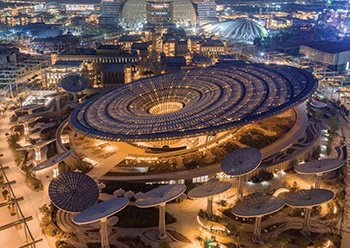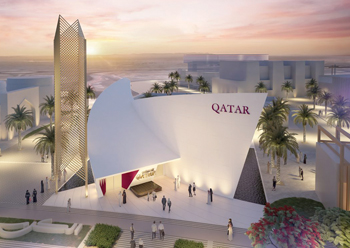
 The Calatrava design envisages a modern interpretation which symbolises Qatar’s progressive outlook of the future while remaining true to its culture and heritage.
The Calatrava design envisages a modern interpretation which symbolises Qatar’s progressive outlook of the future while remaining true to its culture and heritage.
Top global architect Santiago Calatrava, in collaboration with the main contractor Alec Fitout, has unveiled the design for Qatar’s country pavilion at the Expo 2020 Dubai event.
Work on the pavilion, which is being carried out by the main contractor Alec Fitout, is already at an advanced stage and is expected to be completed this month.
Given that the site works began in May, the project represents a benchmark in efficient design and expeditious construction scheduling, said the top designer.
According to Calatrava, the pavilion’s design draws inspiration from the elements represented on the Coat of Arms of Qatar; two crossed and curved swords, encompassing a dhow and island with palm trees. The expressive form of the pavilion eloquently combines and translates these cultural elements to capture movement, mobility, strength, and tradition, it stated.
The design envisages a modern interpretation which symbolises Qatar’s progressive outlook of the future while remaining true to its culture and heritage; fusing sculpture and structure to create an architectural beacon for Qatar’s pioneering vision of the future, and paying tribute to the nation’s rich cultural heritage, it added. Calatrava’s philosophy is grounded in the belief that each innovative design must emanate from its cultural context, conveying traditional sensibility through modern architecture to create truly inspiring structures.
Outlining the design process for the pavilion, CEO Micael Calatrava said: “Inspiration is derived from Qatar’s national emblem to truly capture the essence and vision of the nation. The architectural gesture and structural form of the pavilion, which houses the entire visitor experience, mirrors the shape of the dhow and its grand sails.
“The sculptural monument at the entrance of the pavilion represents an abstract translation and fusion of two intertwined palm trees, while the reflective pools and integrated water features surrounding the pavilion, represent the Arabian Gulf which encompasses the nation of Qatar,” explained Calatrava.
“Once visitors enter the pavilion, they are guided through an immersive experience whereby a deeply symbiotic relationship between the visual arts and the internal spaces engage, inspire and inform them about the past, present and future of Qatar,” he added.
Calatrava pointed out that the close collaboration, flexibility and open communication between all parties had facilitated the rapid design and construction progress which culminates in an impressive construction period of just five months from start to finish.
“The iconic, intersecting structures of the main building will ascend upwards to nearly 15 m in height, with an adjacent sculptural monument rising at 20 m. Internally, the pavilion will consist of two main galleries and exhibition spaces, providing highly engaging, inclusive, and experiential environments for visitors,” he added.





















_0001.jpg)


.jpg)
















.jpg)








.jpg)




